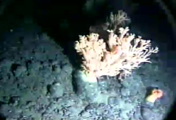Campod and Videograb

Streaming Video - High resolution | Low resolution | RealPlayer Help
Summary
When the Videograb hit the water in 1992, it opened up an underwater world of possibilities for studying the sea floor. Within the Northeast channel of the Atlantic Ocean in an area known as Romey's Peak, there are abundant concentrations of deep sea coral. A Fisheries and Oceans Canada (DFO) research vessel uses this very unique sampling equipment called Videograb and Campod to capture these specimens and live images. DFO scientists are using this state-of-the-art equipment to add to our knowledge and understanding of the resources and natural wonders of our oceans.
Transcript of Video
Narrator
On the tail end of a cruise at sea, Canadian scientists aboard the research vessel Hudson spent several days looking for deep-sea corals. Little did they anticipate the wonders they were about to discover in the depths of the Atlantic off the Nova Scotia coast.
Dr. Donald Gordon
We were up in the northeast channel in an area known as Romey's Peak, and this was an area which was reported to be a very important area for deep-sea corals. And lo and behold we found lots of boulders there and along on the boulders we found quite abundant concentrations of deep sea corals, and particularly a coral that's known as a horny coral, or sea corn, also known as trees by the fisherman. Everybody was just glued to the TV monitors, to the video monitors, as we were doing these drifts and seeing all of the corals. There were lots of ooohs and ahhhs because again of the abundance and their beauty. But the most exciting part was to then decide "Well, let's try to see if we can capture one of these corals with our Videograb system." We were successful. On four attempts we were able to get coral on two of the grabs - and one was capturing that one specimen of coral attached to the rock - and really a cheer went up from everybody on the ship. It was a very, very exciting event!
Narrator
Grabbing a living coral from 350 meters down is difficult. Bringing it back to the surface for further study is a rare opportunity to learn more about the creatures of the deep... and it's all made possible by unique gear designed and built at the Bedford Institute of Oceanography in Dartmouth, Nova Scotia. When the Videograb hit the water in 1992, it opened up an underwater world of possibilities for studying the sea floor. The Videograb consists of a scooplike 'grab' for taking sediment samples and organisms, as well as video cameras for monitoring the 'grab'.
Dr. Donald Gordon
This is a very unique piece of sampling equipment. We haven't seen anything else like it elsewhere in the world. When I go to international meetings and describe our equipment, we get lots of oohs and aaahs from the audience. We've actually had people come here from Australia, Great Britain and Norway to actually look at the equipment because they'd like to make their own similar pieces of sampling gear.
Narrator
Based on the Videograb concept, the Campod was built in 1995. It doesn't take samples - it takes images. The frame holds a 35-millimetre stills camera system, and two video cameras - one that provides a forward looking oblique view... and a high resolution video camera that faces downward.
The Campod and Videograb go out on cruises together. They can't be used at the same time, but they both use the same electronics, operating controls in the laboratory, and the same winches and cable. It takes about a half an hour to change the cable from one rig to the other. Using whichever piece of equipment suits their needs, scientists can capture stunning images, and spectacular specimens, whenever they come upon them - adding to our knowledge and understanding of the resources and natural wonders on our land deep beneath the sea.
Earth Tones is produced in co-operation with Fisheries and Oceans Canada.






